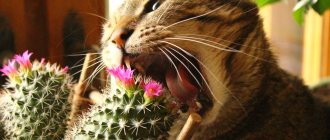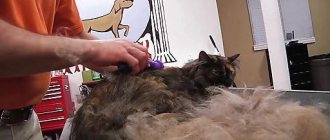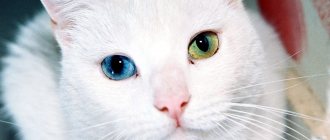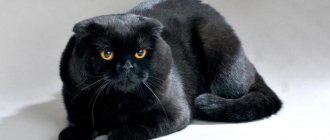Click to share
Many plants found in the home are poisonous to cats.
Caring for a cat involves not only making healthy food choices and regular visits to the vet, but also making sure your home is completely safe for your cat. An inquisitive pet will search everywhere and willingly try plants that may be poisonous to him. Read our article to find out which plants should not be within reach of your little friend. We'll also tell you which safe indoor plants can brighten up your home.
Poisonous plants for cats - what symptoms occur after ingestion?
Potted plants make a home feel cozier and the layout more interesting. However, visual considerations are not the most important thing, especially if you have a cat - it turns out that flowers can be very harmful to your pet. Do you think that your cat is not interested in plants, so they can be left out of the house? This is incorrect thinking because for some plant species, just trying a small amount once is enough to cause irreversible changes in the small organism.
Poisoning from toxic plants causes drooling, diarrhea, lethargy, abdominal pain, lack of appetite, seizures and even death. A bite from the plant may cause immediate symptoms or lead to poisoning only after some time. Dangerous plants cause the cat’s kidneys to work worse and worse, and the heart has an abnormal rhythm. Therefore, do not take risks and check all the plants that you have at home, and in this way you will protect your pet from poisoning.
Symptoms of toxic plant poisoning:
- salivation,
- diarrhea,
- abdominal pain
- lack of appetite
- convulsions,
- no desire to play
- kidney or liver weakness
- acceleration or deceleration of heart rate.
Some indoor and garden plants are very poisonous to cats.
Lilies are poisonous plants for cats
Poisonous plants are those that you know well, you like their smell, and you watch them grow on your windowsill. One of the most poisonous flowers for pets are flowers of the lily family , which are highly toxic and, interestingly, can cause unpleasant symptoms not only in animals, but also in people. If the lily is part of a bouquet decorating your home and you have a cat, discard this dangerous decoration. Both petals and stamens or stems, and even fine pollen, are toxic to these flowers.
Lilies are highly nephrotoxic, meaning they destroy the kidneys. In addition to the usual symptoms that may occur with poisoning, your cat may become thirsty. This will not escape your attention, because wallets rarely end up in a bowl of water. By nature, they do not drink much, but rather eat water from their food. After eating any part of the lily, you may experience abdominal pain due to enlargement of the kidneys.
- The lily family is harmful to cats because it is nephrotoxic. Kidney problems may occur after eating the petals, stamens, stems or pollen because every part of the lily is toxic.
Beautiful lilies that decorate home windowsills and gardens can become dangerous if they are consumed not only by a cat, but also by a person.
Plant allergy
Allergy sufferers may experience various reactions, manifested in the form of skin rashes or depression of respiratory function.
What causes
Spathiphyllum is an allergen only during the flowering period. Pollen with a strong odor leads to an undesirable reaction in the body. The rest of the time the plant is harmless to allergy sufferers.
Spathiphyllum pollen, which has a strong odor, leads to allergies.
Symptoms
The main symptoms of an allergic reaction to spathiphyllum are:
- photophobia;
- dry cough;
- dyspnea;
- weakness;
- sweating;
- hives.
At the same time, symptoms characteristic of bronchial asthma may appear:
- suffocation;
- wheezing on inhalation and exhalation.
Spathiphyllum can cause suffocation and wheezing.
Treatment
If allergy symptoms appear, you should consult a doctor. Both to treat an attack and to prevent its occurrence, specialized anti-inflammatory drugs are prescribed, for example, Cromoglin or Allergokrom, as well as antihistamines (H1-blockers), such as Zyrtec or Claritin. The dosage is determined directly by the attending physician.
Spathiphyllum and cat - what do you need to know?
Spathiphyllum is a plant that is characterized by brightly shiny green leaves and white flowers. Many people like it because it can clear the air of alcohol vapors found in perfumes or harmful substances that come from cigarette smoke. Unfortunately, spathiphyllum is largely poisonous to cats, so if you have a pet, get rid of the plant as soon as possible.
Spathiphyllum is dangerous for cats due to substances that irritate the mouth and cause a burning sensation in the stomach. Symptoms of plant poisoning are, first of all, vomiting, lack of desire to play, aversion to food, but, unfortunately, death. The flowers, rhizomes, shoots and leaves are highly toxic, so there is no place for a flower in the home of a responsible cat lover.
- Unfortunately, the poisonous spathiphyllum is extremely dangerous for cats, so its consumption can even lead to the death of a pet. Substances contained in the plant irritate the stomach and cause a burning sensation.
This plant is preferred for home windowsills, but unfortunately, it is poisonous to cats.
Pet treatment
To relieve intoxication, you should induce diarrhea in your pet using vegetable oil.
First aid is to prevent toxins from entering the cat's blood. If your pet is not vomiting, then you should induce a gag reflex using ordinary warm water, which, in addition, will reduce the concentration of poisons in the stomach. If vomiting occurs on its own, then it cannot be prevented, just like diarrhea, since these processes are aimed at self-purification. If there is no diarrhea, it should also be induced with vegetable oil. For an adult pet, 2-3 tbsp is enough. l. It is necessary to give the animal liquid, securing it well in a position on its side. The most suitable period for manipulation is considered to be the excitation phase, or when the animal is still able to move independently. In this case, you need to observe personal safety measures, since in a gloomy state the cat can
A cat that has been poisoned by a dangerous plant is given adsorbents, for example, activated carbon, in order to neutralize and remove toxic substances from the body. Depending on the weight of the pet, experts recommend 2-5 tablets, divided for convenience into 2-4 parts, but not crushed. Coal should be given at intervals of 3-4 hours. An animal that has been poisoned by dangerous plants must be shown to a specialist. If possible, tell the veterinarian exactly what plant the animal was poisoned with so that proper and effective treatment can be prescribed.
Is lavender poisonous to cats?
Lavender adorns many gardens, but it can also be grown indoors. It is distinguished by its purple color and unusual aroma that repels mosquitoes. Do you want to start growing this plant and wonder if lavender is dangerous for your cat?
Opinions about this flower are divided. Some sources mention that lavender is poisonous to cats and consuming it can cause nausea, vomiting and lack of appetite. The scent of purple flowers is often recommended as a repellent. On the other hand, it appears to be a scent additive for gravel and collars used to relieve stress in cats.
The lack of reliable sources means you must make decisions on your own, which can be risky. Inhaling the scent of lavender should not cause any symptoms in your cat, but consuming it regularly may be harmful. As often happens, too high a dose makes the species toxic.
- The answer to the question of whether lavender is poisonous to cats is unclear. Some sources confirm that the purple flower can cause vomiting and loss of appetite, but the scent has been found in products intended to "purr", such as pheromone collars.
It is recognized that lavender flowers can cause symptoms of poisoning in cats.
Bromeliad - is it poisonous?
A plant from the pineapple family is called guzmanania. Its leaves can have different shades - green, burgundy, brown. The flowers, however, take on a bright, red or orange color. Bromeliads are different in that they dry out after releasing the flower, which is a natural process.
Bromeliads are described as non-toxic to cats, so you can decorate your home with them if you have a pet. Do you want her to look beautiful for as long as possible? Place it out of the cat's reach and take additional care to keep the soil moist and regularly misting the leaves, but not the flowers. Guzmania requires a warm location and sunlight, but do not expose it to direct contact with intense sunlight as this may damage the delicate flower.
- Bromeliads are considered safe for cats. A plant from the pineapple family needs a moist substrate, frequent spraying and a warm place.
Yucca
Yucca is a fairly large houseplant that is popular because it is easy to grow, beautiful in appearance, and has low requirements. You will recognize it by its trunk, overgrown with leaves arranged in a trail. Are you wondering if yucca is poisonous to cats? Unfortunately, yes, so if it decorates your home, get rid of it as soon as possible.
Until recently, it was believed that only garden yucca was harmful to cats, but it turns out that the house plant is also toxic. The dangerous ingredient is saponins. Ingestion of this plant by a cat can lead to vomiting, which in turn leads to dehydration, which is extremely dangerous.
- Yucca is dangerous for cats because of its saponins. Ingestion of the plant may cause vomiting, and it will dehydrate your pet.
Signs associated with the flower
It is believed that you should not give, give away or sell your spathiphyllum; this can take away the happiness of a person who has gotten rid of his plant in this way. On the contrary, giving a new, just purchased flower as a gift is a happy omen. It can be given to both singles and married couples. After all, this plant, according to legends, helps people find their love and keep it for many years.
If a person decides to buy a flower on his own, it is worth following the following rules in order for the purchase to be successful and bring happiness:
- The best days to buy are Wednesday, Friday and Saturday.
- The seller should be a blonde with blue eyes.
- You cannot collect change after payment.
It is believed that “women’s happiness” perishes when bad energy prevails in the house from constant quarrels and discord. Therefore, it is worth carefully monitoring the appearance of the plant, because this is a kind of indicator of healthy relationships between family members.
Ficus
Ficus is an ornamental plant that decorates many homes. It has gained recognition due to the lack of difficulties in growing and its appearance, which can diversify even the simplest interiors. The houseplant, also known as ficus, comes in many varieties.
Any variety of this plant will irritate both your skin and the mucous membranes of your pet's digestive tract.
- Easy to grow, ficus comes in many varieties, all of which are dangerous for cats. It can irritate your pet's skin and digestive tract.
All varieties of ficus are poisonous to cats.
Why is the flower dangerous? Is it poisonous or not?
Unfortunately, spathiphyllum poses a threat to cats (is this flower dangerous for humans?). The poison is contained in plant sap.
If an animal chews the leaves, it is likely to get a burn to the mouth and damage the digestive tract. In addition, the poison can get into the mucous membranes of the eyes. Such consequences are caused by the calcium oxalate contained in the plant juice.
Calcium oxalate (CaC2O4) is a salt of oxalic acid, it is poorly soluble in water and settles in the renal pelvis, which subsequently causes urolithiasis.
Oxalic acid itself is quite poisonous, so its salts also inherited this feature.
Rue - cats don't like its smell
Common rue grows up to a meter in height and its flowers are small and yellow. The plant is not used to decorate houses, but it is used in herbal medicine. However, this is not the only function that a regular root can perform. Cats don't like its smell, so many people grow it in the garden to scare away unwanted guests.
Is your home visited by your neighbors' pets and are you concerned about the health of your cats? Then take care of your health and get ordinary rue, which will scare off uninvited guests with its aroma. Lavender will work in a similar way, but not all cats will bypass it.
- Common rue is a plant that decorates gardens and is used in herbal medicine. Cats don't like its smell, so you can sow it on your property to deter intruders.
How to landscape an apartment or garden plot without harming the cat
Fortunately, the choice of garden and ornamental plants that are safe for cats is quite large and allows you to decorate your garden plot or windowsill to suit every taste. The most common and attractive green spaces include:
- Cat grass is a fast-growing plant that does not require much care. Seeds are freely sold in many stores, sprouts appear within 3-5 days after planting, and can be grown both in garden plots and at home. The name itself suggests that this herb is beneficial for cats and has a beneficial effect on the functioning of the gastrointestinal tract.
- Begonia is suitable for planting on a personal plot, and its flowers will decorate the local area throughout the summer. Absolutely harmless to cats.
- Catnip – grown in the garden or in pots, is very attractive to cats.
- Fern is harmless to the animal and provides shelter in the shade of leaves on hot days.
- Any variety of roses will not only decorate the area, but will also not harm the cat.
To distract your cat’s attention from plants that are harmful to her and, at the same time, ensure that the body receives the required amount of vitamins and fiber, you can plant cereal seeds (oats, wheat, barley) at home yourself. This grass germinates quickly, does not require special care and is beneficial for the pet’s body. In addition, a miniature lawn will become an original decoration for the window sill. If the cat does not show interest in green spaces, the owners can independently mix crushed grass into the animal’s food.
Safe indoor plants for cats - do they exist?
Are you under the impression that you have to go completely green at home to keep your pet safe? This is wrong! Flowers that are safe for cats also exist, and their appearance is no different from toxic species.
Safe potted flowers are ferns, more precisely the haughty nephrolepis , with which you can decorate your home. This beautiful plant will look great hanging from the ceiling, but it can also stand in a pot. The plant is non-toxic to cats, is easy to grow and is effective at purifying the air. Nephrolepis will do best in a slightly shady position and is regularly misted and watered to keep it constantly moist.
Flowers that are safe for cats are common violets, also called African violets . The plant is small in size and has a beautiful color - purple is the most popular. Make sure that the violet has a clear position, but without direct contact with the sun's rays. Never spray the leaves and water the flower only to the base so that it can take up the required amount of water.
Indoor plants that are cat-safe add variety to your space, but they can also help your pet. Don't forget to sow grass regularly - oats are best, as they will rid your cat of fur in the digestive tract. Beware of a plant called Cyperus alertsnifolius Zumula - it is often called cat grass, but the animal cannot eat it because it is poisonous.
Video: about the spathiphyllum plant
Read further:
Why is the poisonous indoor spurge flower dangerous?
Oleander: poisonous plant or not
Dieffenbachia flower - poisonous or not
Rhododendron flower (azalea) - poisonous or not for humans and animals
Green stool: what does it mean?
Article rating:
Share with friends:
You may also be interested in:
Potassium cyanide poisoning - symptoms and signs, how quickly death occurs
Top 7 poisonous herbs for humans
Toxic substances and their effects on the human body
Deadly poison curare - methods of application











